Testing the Garmin Fantom 24 in a new world of solid-state radar
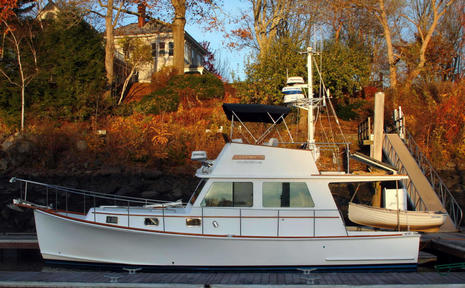 It went unmentioned at our large family Thanksgiving feast last week, but I am thankful that solid-state radar became omnipresent in our marine electronics world this year. In fact Gizmo’s four test radomes now all share the solid-state virtues of near instant power up, low power draw, low emission levels, and long life (at least theoretical). They are all decent performing radars, too, and several offer very special features that only seem possible with solid-state technology. In this entry I’ll try to sort out the field, while also sharing first impressions of that spanking new Garmin Fantom 24 radome.
It went unmentioned at our large family Thanksgiving feast last week, but I am thankful that solid-state radar became omnipresent in our marine electronics world this year. In fact Gizmo’s four test radomes now all share the solid-state virtues of near instant power up, low power draw, low emission levels, and long life (at least theoretical). They are all decent performing radars, too, and several offer very special features that only seem possible with solid-state technology. In this entry I’ll try to sort out the field, while also sharing first impressions of that spanking new Garmin Fantom 24 radome.
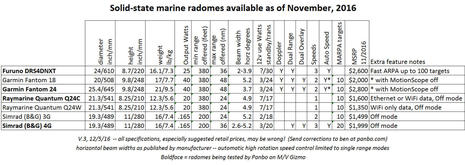 While the solid-state radome comparison table above — click it bigger to see the detail — took considerable time, please consider it a work in progress. Readers and manufacturers may have corrections, but it is a start at understanding the similarities and differences. For instance, the claimed maximum transmit power draw of these radomes only varies from 17 to 30 watts, or 1.4 to 2.5 amps at 12 volts (and I suspect that Furuno number is high in practice).
While the solid-state radome comparison table above — click it bigger to see the detail — took considerable time, please consider it a work in progress. Readers and manufacturers may have corrections, but it is a start at understanding the similarities and differences. For instance, the claimed maximum transmit power draw of these radomes only varies from 17 to 30 watts, or 1.4 to 2.5 amps at 12 volts (and I suspect that Furuno number is high in practice).
Low power draw is especially important on sailboats, but it also means lighter cables and easier installs on all boats. And though the standby draws are pretty much trivial, I’ve still pointed out in the Extra Features column that both Navico (Simrad plus siblings B&G and Lowrance) and Raymarine let users turn the radars on and off from their multifunction displays. This feature, as well as Raymarine’s unique WiFi utilization, are illustrated in Panbo’s Quantum Q24C review.
Speaking of which, strong evidence suggests that Raymarine is helping Humminbird to join the list above with a “HB 2124 CHIRP Radar” version of the Quantum Q24. There may be five brands of solid-state radomes soon, and I say the more the merrier (and congrats to Humminbird and Raymarine for forging what looks like a smart partnership).
 Now let’s discuss other aspects of the solid-state radome spec list with screenshot illustrations. This one shows the Garmin Fantom 24 — first discussed here on Panbo — just after I installed it at the inner Camden Inner Harbor dock pictured at the top of the entry. It’s a radar challenging spot tightly surrounded by boats, floats, piles, buildings and steep terrain, but the Fantom is doing fairly well at its minimum 1/16nm range (380 feet) and AutoLow gain. (Note how the gain level and other important settings nicely overlay on the bottom left of the screen. Thus I didn’t need to tap Menu, then Radar Options, to see that the Doppler MotionScope feature is turned on; it’s just that few boats are moving around here these days.)
Now let’s discuss other aspects of the solid-state radome spec list with screenshot illustrations. This one shows the Garmin Fantom 24 — first discussed here on Panbo — just after I installed it at the inner Camden Inner Harbor dock pictured at the top of the entry. It’s a radar challenging spot tightly surrounded by boats, floats, piles, buildings and steep terrain, but the Fantom is doing fairly well at its minimum 1/16nm range (380 feet) and AutoLow gain. (Note how the gain level and other important settings nicely overlay on the bottom left of the screen. Thus I didn’t need to tap Menu, then Radar Options, to see that the Doppler MotionScope feature is turned on; it’s just that few boats are moving around here these days.)
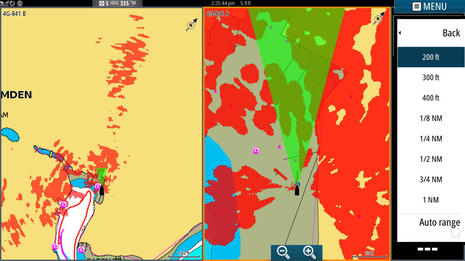 Now here’s the Simrad 4G — first tested in 2011! — running in the same spot but with the right hand window set to its minimum 200-foot range (about 1/32nm). In my experience the uniquely tight ranges offered by 4G (and 3G) are justifiable, as evidenced by how this screen shows a lot more of the floating dock structure ahead of Gizmo than the Fantom does. (Note that the old Navionics chart doesn’t show the current dock layout or dredging, but the current online Navionics version is close to perfection.)
Now here’s the Simrad 4G — first tested in 2011! — running in the same spot but with the right hand window set to its minimum 200-foot range (about 1/32nm). In my experience the uniquely tight ranges offered by 4G (and 3G) are justifiable, as evidenced by how this screen shows a lot more of the floating dock structure ahead of Gizmo than the Fantom does. (Note that the old Navionics chart doesn’t show the current dock layout or dredging, but the current online Navionics version is close to perfection.)
The Furuno and Raymarine radomes image that spot and other very close targets much like the Fantom, and the 3G/4G difference is probably due to their unusual FMCW solid-state radar technology. All the others use pulse compression instead of continuous wave, as reflected in the spec table’s seemingly strange Output Watts column. Note, too, that this screen also shows how the 4G can overlay two independent radar ranges on charts, which was another unique feature and one I’ve personally appreciated a lot.
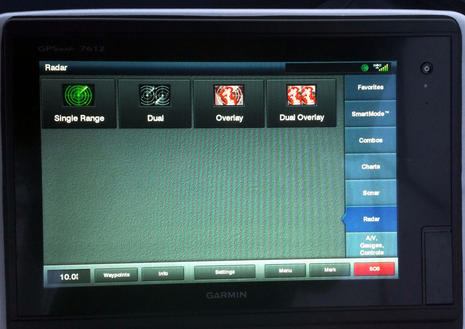 So it was great when I first opened the Garmin 7612’s default Radar mode screen after installing the Fantom and saw Dual Overlay. It’s also interesting because the original Fantom open array demoed in February had dual range, but only one could be overlaid on a chart. Almost all (current) MFDs and most of the devices attached to them are sometimes updated to add features (and/or fix bugs), but I think that solid-state radar is particularly prone because so many of the engineering teams are relatively new to the technology and the competition is fierce. More dual overlay, Doppler, and automatic tracking features please.
So it was great when I first opened the Garmin 7612’s default Radar mode screen after installing the Fantom and saw Dual Overlay. It’s also interesting because the original Fantom open array demoed in February had dual range, but only one could be overlaid on a chart. Almost all (current) MFDs and most of the devices attached to them are sometimes updated to add features (and/or fix bugs), but I think that solid-state radar is particularly prone because so many of the engineering teams are relatively new to the technology and the competition is fierce. More dual overlay, Doppler, and automatic tracking features please.
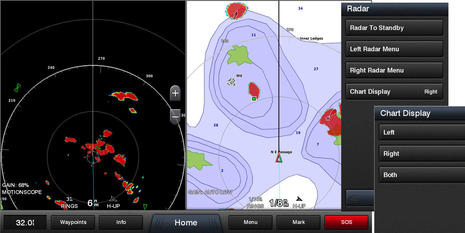 So here I have Fantom’s dual overlay mode in action, and it turned out to be virtually the same mode as plain dual range, in a good way. That’s because it only takes two finger (or GRID or wireless remote control) taps to find a neat little menu that lets you display (underlay?) charts on either or both ranges. It’s easier to set up the dual range and chart configuration you may want, or change it quickly, than it is on the 4G, but, then again, Garmin’s dual range radar is a special mode that can’t be mixed with other windows while you can mix radar ranges and overlays any way you want on NSS evo2 and Zeus2 screens.
So here I have Fantom’s dual overlay mode in action, and it turned out to be virtually the same mode as plain dual range, in a good way. That’s because it only takes two finger (or GRID or wireless remote control) taps to find a neat little menu that lets you display (underlay?) charts on either or both ranges. It’s easier to set up the dual range and chart configuration you may want, or change it quickly, than it is on the 4G, but, then again, Garmin’s dual range radar is a special mode that can’t be mixed with other windows while you can mix radar ranges and overlays any way you want on NSS evo2 and Zeus2 screens.
 It’s worth discussing how Garmin handles radar overlay with regular single-range radar because that too is different, not in a bad way. The collage above shows the main Radar Menu you’ll see with any radar screen or window (dual range/overlay excepted), plus its major submenus. Note “Chart Display” at the top of the Radar Setup menu. So, unlike all the other MFDs I’m familiar with, you don’t open a chart window and overlay it with radar; on Garmin’s you open a radar window and underlay it with Chart Display.
It’s worth discussing how Garmin handles radar overlay with regular single-range radar because that too is different, not in a bad way. The collage above shows the main Radar Menu you’ll see with any radar screen or window (dual range/overlay excepted), plus its major submenus. Note “Chart Display” at the top of the Radar Setup menu. So, unlike all the other MFDs I’m familiar with, you don’t open a chart window and overlay it with radar; on Garmin’s you open a radar window and underlay it with Chart Display.
Of course the menus also show many other controls Garmin’s latest MFD software provides for Fantom radars, and, in many cases, their magnetron radars as well. They are discussed rather briefly in a user manual like the 7612’s (PDF download here) and if I fail to cover a detail that interests you in this or upcoming radar entries, don’t hesitate to ask.
 Here’s a Fantom 24 dual-range, dual-overlay screen, and I hope you can imagine how useful it could be in certain situations, like if there were rain cells out ahead that I was trying to dodge. I have not yet taken a stormy opportunity to compare these radomes (like 2012’s 4G vs Ray HD in rain), but that will be interesting.
Here’s a Fantom 24 dual-range, dual-overlay screen, and I hope you can imagine how useful it could be in certain situations, like if there were rain cells out ahead that I was trying to dodge. I have not yet taken a stormy opportunity to compare these radomes (like 2012’s 4G vs Ray HD in rain), but that will be interesting.
It will also be good to do more long-range testing, especially because I was somewhat surprised that the fairly large Fantom 24 with its 40 watts of output didn’t see further in situations like that 16nm range window at right above. I am aware that dual range means less on-target energy for each, but the results look similar with the Fantom 24 on single range, and also with manually increased gain. Garmin may need to do some Fantom radome tweaking — heck, they’re not even shipping quite yet — but before we leave this screen, note how Fantom’s Doppler-assisted MotionScope is purple highlighting a lobster boat that suddenly accelerated toward Gizmo’s port quarter from 1/4 mile away. Useful!
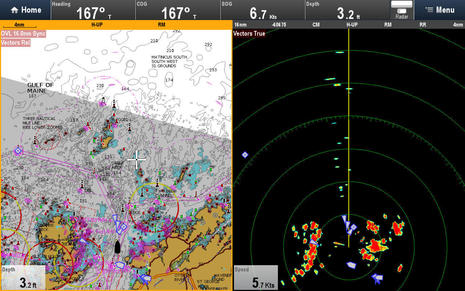 More on target tracking soon, but first check out this screen showing the Raymarine Quantum Q24 looking ahead at 16nm range. Panbo’s initial Quantum testing is here and I took this screen before moving the Q24 up to the mast (where the WiFi data connection is still working fine and it can now see behind Gizmo). Yet its 20 watts of transmit power images quite like the Fantom’s 40 watts in that important 8-mile range, plus it’s peeking at a little of what’s much further away, including a nav aid at 20 miles (I think).
More on target tracking soon, but first check out this screen showing the Raymarine Quantum Q24 looking ahead at 16nm range. Panbo’s initial Quantum testing is here and I took this screen before moving the Q24 up to the mast (where the WiFi data connection is still working fine and it can now see behind Gizmo). Yet its 20 watts of transmit power images quite like the Fantom’s 40 watts in that important 8-mile range, plus it’s peeking at a little of what’s much further away, including a nav aid at 20 miles (I think).
In fact, I’m not sure that solid-state transmit power has that much to do with actual performance, but more testing is in order and software updates may change things. But let’s also note that the super easy-to-install WiFi-only Quantum is about half the cost of the Fantom 24 and almost half the weight.
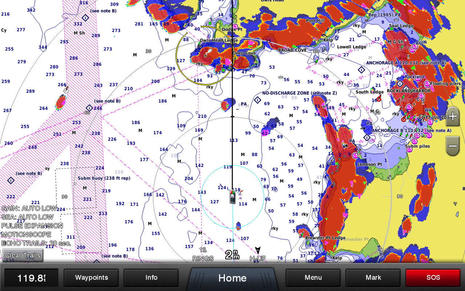 But neither Quantum nor 3G/4G can currently provide the instant and automatic target assistance seen on this screen (though Doppler updates are vaguely rumored). I was motoring to Rockland in hopes of testing MotionScope on the state ferries, but the scenario got more realistic when I spotted two small speeding boats ahead but couldn’t tell where they were headed. The purple target 2 miles off Gizmo’s starboard bow says “vessel coming my way” and the longish echo trail says “fast.”
But neither Quantum nor 3G/4G can currently provide the instant and automatic target assistance seen on this screen (though Doppler updates are vaguely rumored). I was motoring to Rockland in hopes of testing MotionScope on the state ferries, but the scenario got more realistic when I spotted two small speeding boats ahead but couldn’t tell where they were headed. The purple target 2 miles off Gizmo’s starboard bow says “vessel coming my way” and the longish echo trail says “fast.”
Interestingly, the other fast boat target — just to port, a little over 2 miles away — had shown purple just before I took the screenshot, and if you look closely it’s just starting to turn all green, which will indicate that it’s moving away. So far Fantom is the only radar using Doppler to show both coming and going target motion, as I saw in Miami, but several times I noticed the Fantom 24 briefly go thru this red phase as the relative motion changed.
Incidentally, the latest Fantom MFD software offers a choice of seven different radar color schemes with automatic contrasting MotionScope colors, but only the red one shows “true color” target hardness shades. Also, that small purple incoming target behind Gizmo was yet another working lobster boat that was going the other way moments before.
![]() Doppler-assisted motion highlighting is great but, dang, look what the Furuno DRS4D-NXT was doing at the same time. Since enthusiastically reviewing the NXT Doppler assisted radome in early August, I’ve learned that while I like its Target Analyzer mode in busy tight situations like summer Camden Harbor, out in the Bay I tend to turn it off and count on the NXT’s incredible Fast Target Tracking (also known as Doppler-assisted ARPA). This is a good example why. Quite quickly and totally automatically, the NXT was tracking the two fast boats with graphics accurately indicating their real headings and speeds, and more detail just a tap away. (And I’m pretty confidant that it was about to lock onto the lobster boat that had just turned toward Gizmo’s stern.)
Doppler-assisted motion highlighting is great but, dang, look what the Furuno DRS4D-NXT was doing at the same time. Since enthusiastically reviewing the NXT Doppler assisted radome in early August, I’ve learned that while I like its Target Analyzer mode in busy tight situations like summer Camden Harbor, out in the Bay I tend to turn it off and count on the NXT’s incredible Fast Target Tracking (also known as Doppler-assisted ARPA). This is a good example why. Quite quickly and totally automatically, the NXT was tracking the two fast boats with graphics accurately indicating their real headings and speeds, and more detail just a tap away. (And I’m pretty confidant that it was about to lock onto the lobster boat that had just turned toward Gizmo’s stern.)
I’ll add that the Furuno NXT can do Target Analyzer and fast ARPA simultaneously, but you can’t have true color returns with Target Analyzer, it doesn’t highlight boats moving away, and at least on the Furuno TZT2, there’s no echo trail option at all. {12/2 update: TZT2 is about to get echo trails and trail averaging with software update. See comments.}
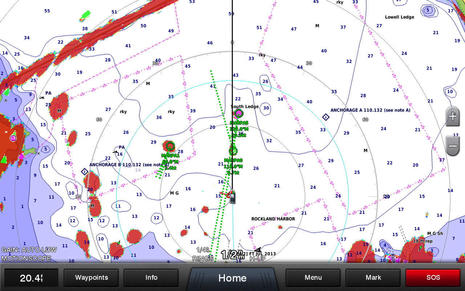 Finally, here’s a Fantom 24 screen showing its MARPA capabilities, and it’s particularly nice because the target calculations confirmed what the MotionScope was already indicating in a more general way. The target off to port was a little tug/barge combo and it’s probably not highlighted because it was moving below MotionScope’s speed minimum — which is 5 knots, I think, while Furuno’s is 3. Meanwhile the two boats ahead are above the speed threshold and MotionScope was already showing their going and coming nature before my MARPA selecting taps even began the calculation process and its more refined results. And notice how the Fantom is also highlighting a going away vessel on the other side of the rocky Rockland breakwater.
Finally, here’s a Fantom 24 screen showing its MARPA capabilities, and it’s particularly nice because the target calculations confirmed what the MotionScope was already indicating in a more general way. The target off to port was a little tug/barge combo and it’s probably not highlighted because it was moving below MotionScope’s speed minimum — which is 5 knots, I think, while Furuno’s is 3. Meanwhile the two boats ahead are above the speed threshold and MotionScope was already showing their going and coming nature before my MARPA selecting taps even began the calculation process and its more refined results. And notice how the Fantom is also highlighting a going away vessel on the other side of the rocky Rockland breakwater.
So far the Fantom 24’s MARPA seems a lot like what I see on the Quantum and the 4G. All can definitely be useful but none compares to the Furuno NXT ARPA even just in accuracy and speed, and the NXT also does an excellent job of picking which targets to track. With NXT no target tapping — or accidental double tapping, as seen above — is usually needed (though it’s possible).
But I’ll repeat: these are all decent performing radars in my view, and that’s good because you don’t get to pick radar alone these days. What’s more, I don’t know of any reason that all the features highlighted here are not possible from any determined manufacturer, at least eventually. Behold the new world of solid-state radomes and rejoice.
PS 5/8/17: How does solid state radar perform in rain? This weekend I got wet trying to find out more definitively, and can tell you that all four of the radomes discussed in this entry see through light rain no problem, in fact without the need of the rain filters they all have. The Furuno NXT also showed the ability to see heavier rain about 8 miles away, as shown below, and that rain imagery could be completely cleaned off the screen with the rain filter. The other radars did not seem to see that distant rain, but it also didn’t stick around for very long. So I will have to wait for wetter weather


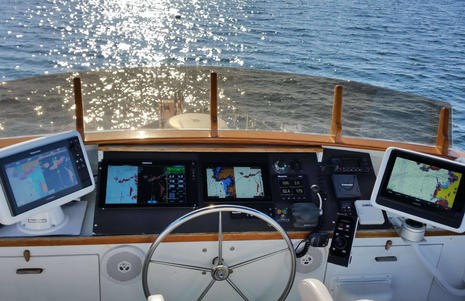

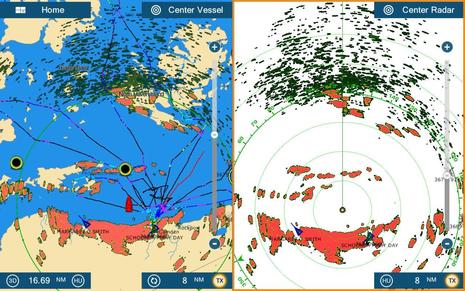

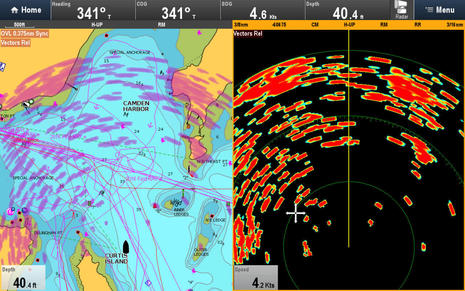
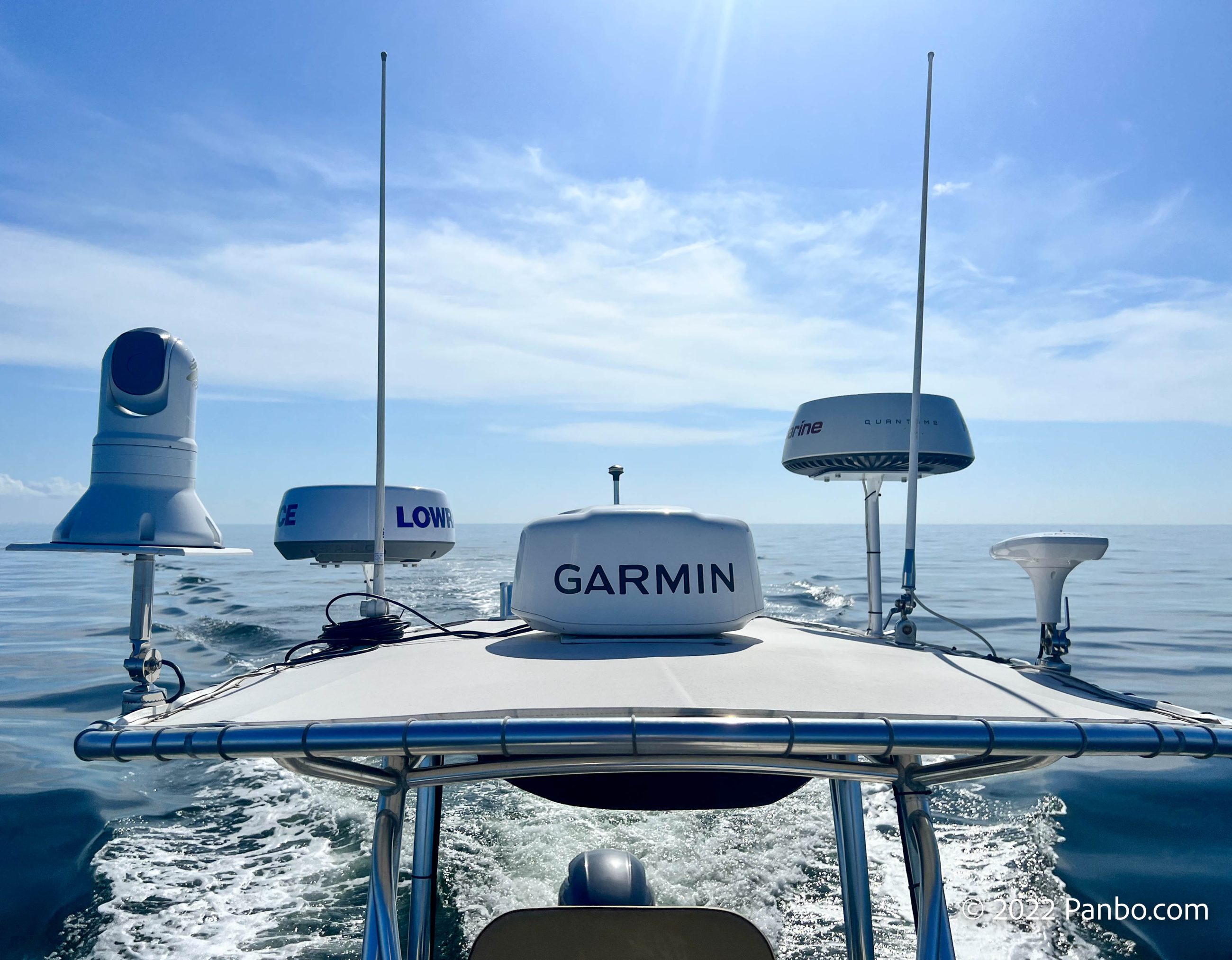








Excellently written sir! I think the next logical step for manufacturers is phazed arrays! Say 4 small pods, one on the front, one on each side, one on the stern. Power only to each, then wireless to the head. Second revision could include 360 cameras too! They could be accurate enough to auto dock the boat one day! Wish you were down on the gulf coast! Stay warm!
The revelation of the NXT was enough for me to remove (and sell) my DRS4D conventional dome and upgrade. I am hoping to see a solid state Furuno open array before spring, but if not, I will be installed another dome.
The fast target tracking feature is a game changer for helping avoid trouble in the fog.
Hi Ben,
Furuno’s TZT2 can do echo trail and echo average with the latest Software version 4.01.
Also C-Zone’s digital switching is now compatible with the TZT2 and a lot more. I saw that during the METS in Amsterdam.
Regards Ben
Thanks, Ben, that great to learn and also a good example of a point I tried to make! The new TZT2 software isn’t actually out yet, but there’s a new “Johnny Electron” post on the Furuno Forum saying it will happen “very VERY shortly.”
http://www.furunousa.com/Support/Forum.aspx
Thanks for great writeup! Phased arrays indeed are the future, no moving parts and practically unlimited scanning speeds. Plus all sorts of interesting new things to try, dedicated per target tracking beams with range-tailored adaptive TX-power perhaps.
See your still in the water Ben. Great photo! Hope you like it over in our neighborhood. See you have fried the vegetation along the banking with all that radar power. LOL
Maybe you could do a Holiday shopping list using all the great gadgets you have reviewed over the last year.
Hope to see you soon.
Allan
It’s a lovely, peaceful corner of the harbor, Allan, and I made lots of bird friends while slowly divesting Gizmo of outdated cruising provisions. The boat is staying in all winter and I’m busy installing a Webasto hydronic heating system. It’s a darn complicated install, despite excellent support from Sure Marine Services in Seattle, but I’m excited about the hoped-for results.
Panbo advertisers can take care of your holiday needs!
Ben, good information however you may have missed one of the most important points…does it work in heavy rain! For the record I am using a Furuno DRS4D-NXT unit which does all of the things you mentioned quite well however a few months ago while navigating around an anchorage in Miami, a serious rain shower occurred for about 15 minutes, could barley see the flag on the bow. The DSR radar went completely red, no amount of tuning would bring back the image. In a panic I fired up my good old fashioned 25 kilowatt magnatron radar with a 6′ wide antenna, and after a painful 2 1/2 minutes of warm-up, I could see both shorelines and a dozen vessels.
At the Ft. Lauderdale boat show I confronted the Furuno technician who admitted that the DRS radar would not function in heavy rain! The antenna is too small was the stated reason. I continued on to both Raymarine and Garmin and after a bit of coaxing, they admitted the same problem on dome antennas. One could argue “Who needs a radar that only works on sunny days?”…I was planning to remove my old magnatron 25 kW radar because I need the helm space for another flat panel display, I changed my mind!
In summation, I believe the new microwave radars are great, however marketing needs to inform the public that there is a significant restriction to their usefulness in heavy rain.
Thanks, Cyril
Thanks, Cyril! I edited your comment a bit to clarify that you have both a Furuno NXT solid-state radome and a 25kW magnetron open array, but please holler if I made mistakes. and hopefully readers who’ve had radomes in downpours will report in.
and hopefully readers who’ve had radomes in downpours will report in.
The situation you describe is certainly a concern but it does sound like you’re talking about very heavy rain. I’ve rarely had Gizmo underway under a real downpour with any of the radomes I’ve tested over the years, but I recall that Raymarine HD and Simrad 4G domes did pretty well filtering out moderate rain when I wrote this entry:
https://panbo.com/archives/2012/07/simrad_nss8_raymarine_e7_with_radar_in_the_rain.html
Of course that entry is largely about how the radar reflecting property of rain allows a good radar to help track rain cells at a distance, but I imagine that there could be so much airborne water nearby that it would be like having your boat inside a tin can.
I’ll try to fire up this current set of radomes in conditions like you describe (though maybe just at the dock
I’ll add that when Furuno first demoed the NXT in Miami I recall Eric Kunz sounding proud about the performance he’d already seen in rain, particularly the ability to see hard targets while filtering out the water drops.
https://panbo.com/archives/2016/03/solid_state_radar_2_the_doppler_effect.html
On the other hand, I’ve heard Eric and other radar experts say that relatively weak solid-state radars still can not do certain things as well as high power magnetron radars (like your 25kW beast), though usually they mean extreme ranges and bird detection.
Ben,
I have to agree that there are two worlds that exist with Radars. The very best way to get both is to install both! I am about to do an install with a 25KW Super HD 6′ open array AND a Quantum 24″ Dome. Excellent for both birds/weather and outstanding up close in tight harbors….AND to boot, Raymarine offers the Dual Radar option with the Later Lighthouse FREE software update. — Good call Raymarine!
Don’t you mean 12kW, Tom? I don’t see a Ray 25 available:
http://www.raymarine.com/view/?id=168
Nonetheless you’ll have high performance radar at all ranges, with three ranges usable at once (I think), plus radar redundancy. I tried Lighthouse’s dual radar ability when I first installed the Quantum and it works great (and I think that all the big brands offer it now).
https://panbo.com/archives/2016/09/testing_raymarine_quantum_q24_radar_solid_on_many_levels.html
The hardware contrasts are pretty startling, though. The Raymarine Super HD 6ft 4in is equal in weight to a stack of 5 Quantums and when transmitting uses the power of 6.5 Quantums.
Incidentally, what Ray calls Sleep Mode in their specs is what I called Off Mode in the comparison table (since Off is how it’s put on the MFD screens). Your beast will use almost 2 transmitting Quantums in Standby mode (30W) but only 1.2 in Sleep/Off mode.
I really doubt amateur users have anything to fret about the new radars that would drive them to stay with magnetron or gasp, have two radars, for heavy rain, eh?
Amature fair weather boaters seem unable to cope with reading mag based Radar in the seas that accompany heavy rain.
Better to get full AIS with your new Radar rather than have two radars, and do what is done by those without Radar … stay out of busy channels, know how separation zone scheme in your waterway, have two radios to listen to VHF, be ready to make noise, have a lookout with their head out of the boat, and go slow.
The doppler feature on the new radars look wonderful at giving minimally skilled users easier to interpret images and AIS helps the truly challanged to get what’s going on around them even for the big boats that transmit. Just maybe my wife can use it next time while I keep my head outside the boat.
Wouldn’t you agree?
Well, partially agree. The Doppler-assisted motion highlighting features can definitely help new radars users understand what the target screens mean faster and better. But they can also help a more experienced user keep his or her head out of the boat.
And I think that the faster, more accurate, and more automated ARPA that Furuno has managed to put in NXT is fantastic for any sort of boater.
I also think that a good radome and a Class B AIS transciever can make a decent and affordable collision avoidance system for many vessels. But if someone like Tom above has the boat and budget to add a whomping open array radar, they’re going to have an even better system and other capabilities.
Ben, another thing I would like to see once they have room since everything is getting smaller in the domes is built in lightening warning. Maybe something that would tell how far and possibly even show strikes on the screen. Technology is there for cheap today, just not integrated. Also, super heavy rain does turn our Lowrance 3G to red in all but the smallest two scales. Which is fine because we always drop down to 8 kts when we get into super heavy rain.
oops, it was a 12K, not 25K….
Every time I see one of these articles, I get technology “buyer anxiety” having chosen to put a magnetron radar on my boat in a Garmin system. It always seems that newer is better. In my case, the radar is a large six foot open array on a sportfishing boat and being able to spot birds is a critical requirement. I had the choice between the 6 foot Fantom array and the 25kW xHD2 conventional magnetron.
Since there are almost no Fantom units in service and it is especially hard to compare performance finding birds because the conditions can vary so much, I attempted to get as much information as I could through industry contacts. Interestingly enough, technical people from Garmin, Simrad, and Furuno all agreed that the 25kW magnetron would do a better job spotting birds at long ranges (over 3-4 miles). One of the people told me it was partly due to the technology and partly due to the more aggressive signal processing algorithms in the solid state radars that give them those “clean” screen images. They also said it would be a push as to which would be better at picking out very small closer targets such as pot floats.
In the case of the two Garmin 6 foot arrays, the conventional 25kW has a narrower beamwidth at 1.1 degrees than the Fantom at 1.25 degrees. That’s a little hard to grasp since I always understood beamwidth to be primarily a function of the length of the array.
If I were Ben, I would just get a Fantom 6 and mount it on a pole above the xHD2 and give you all a side by side screen shot! Wish Garmin would give e a loaner to try.
I just replaced the comparison table with version 3, largely thanks to suggestions from Garmin. It turns out that the Fantom 18 and 24 can automatically change rotation speed to track nearby fast targets, but only if MotionScope is turned off. Also the feature only works in single range mode, but I’m pretty that’s true of all radars with multiple rotation speeds.
Garmin further suggested that listing minimum ranges could be confusing, which is true, so I changed the labels to “range offered.” How close a radar can image a target, or minimum detection range, is another subject. Garmin claims 20 feet for the Fantoms, assuming the target is tall enough to be in the vertical beam, but I think it varies some in practice.
Great article and chart, Ben. Pulls together a lot of information I have been trying to grok from multiple sources. Many thanks!
I am still wondering about the Raymarine WiFi setup: the radar mount on Aria is about 15′ off the deck and about 20′ from the companionway, which is where the MFD is located. Is this pushing the limit of the range of the Raymarine WiFi?
I like the idea of WiFi, even though we already have (Furuno) cable pulled from the radome to the companionway display.
Hi Peter, I think that WiFi connection scenario will work fine but if you save some money with a WiFi-only Quantum make sure you can return it and thoroughly test it right away. You’ll still need 12v power at the radome, but the power wires inside the Furuno cable are probably sufficient. Happy Holidays!
Ben, I should add to my recent comment about Raymarine WiFi that they have an excellent write-up on Wifi installation issues in their Quantum Radar Installation manual which can be accessed at:
http://www.raymarine.com/content/index.cfm?id=13531&collectionid=95&col=13535
Thanks! Peter
Right, I was impressed too:
https://panbo.com/archives/2016/09/testing_raymarine_quantum_q24_radar_solid_on_many_levels.html
Ray puts out thorough, well written and illustrated manuals these days, much appreciated.
Ben ARPA as a feature seems like a really big deal / big advantage when choosing a MFD/Radar combo. Do I recall correctly from a previous Panbo entry that this feature is expected to appear in software updates for the other products or am I confusing that with doppler?
Dan
Dan, I think that ARPA is a big deal when it works as well as it does on the NXT. It’s constantly looking all around your boat for moving targets of interest, which it then nails with a vector graphic. It doesn’t even seem to care about what range you’re displaying the radar in (and it never annoys you with an audible “target lost” alarm).
But Furuno has been the only manufacturer to put ARPA in recreational radars for some time, and now they’re apparently using Doppler to improve it. I have no idea if or when the other manufacturers can catch up, but I’m guessing they feel motivated
As for the Doppler target highlighting that both Furuno and Garmin offer, I don’t think that updates to other existing solid-state radars and/or radomes should be “expected” but possibilities are definitely rumored.
Furuno feels really compelling.
Okay, I need new radar, but I have a very basic question.
I understand the concept of target separation and how it relates to horizontal beam width. A 24 inch radar with 3.7 degrees horizontal beam will have better target separation then an 18 inch unit with 5.2 degree width.
However, with the new technology, in particular Garmin’s Fantom Dome radar, does MotionScope, Pulse Compression, High Antenna Gain and Doppler all combine to make target separation almost as good on the smaller 18 inch Fantom as one would see using the 24 inch radar? What does $800 additional for the 24 inch dome buy?
After all, if these Doppler radars can see birds why can’t the smaller 18 inch, 5.2 degree beam Fantom see two lobster boats working their traps next to each other as separate targets? What would a tug with tow on shortened scope look like on my 7612 chartplotter? Wish Garmin had screen shots on their web site to show the comparison between both 18 & 24 inch Fantom dome radars in situations like this.
Excellent question, Richard, and I think I know some of the answer.
First of all, I don’t think that Doppler has anything to do with what’s generally called beam sharpening. In fact, one of the odder things I’ve seen with both Garmin and Furuno Doppler target motion is when they briefly paint the same target both red and green (or some other color combo in the Garmin case).
Usually what’s actually happening is that the target has stopped or changed direction and the radar has not quite caught up. But I’ve also seen the Furuno highlight a boat red but leave its wake green because the wake wasn’t going fast enough (over 3 kn in Furuno’s case), and I’m pretty sure I once saw two tone a large turning ship because one end was turning toward me and the other away!
At any rate, I’m pretty sure that what I’ve seen means that Doppler, at least as used now, doesn’t even know it’s looking at the same target as it analyses motion, and also that it responds to motion fast.
Now what’s hard to get our collective head around is this: How important is it to distinguish two close together lobster boats if you’re confident that the one which starts heading your way at speed will quickly pop on your display?
As for beam sharpening, it is only seen on solid-state radars to my knowledge, and I think that Garmin is the only solid-state manufacturer who doesn’t claim some form of it. Regardless, I’m quite sure that the Fantom 24 has better horizontal resolution than the 18. The old axiom that more power means more range is somewhat shaky at this point, and power is really hard to compare between solid-state and magnetron, but less beam width = more hoz resolution remains true.
Simrad trail blazed adjustable beam sharpening with the 4G, and Furuno put similar in the NXT. Both definitely work in my experience but they come with a certain jaggedness that’s somewhat discomforting at high settings. I tried to discuss this with Forum poster “Salmon” but I think he concluded that I work for Navico. Which is kind of funny given that Navico doesn’t even advertise here (not that advertisers get special treatment). Well, funny with a bitter taste.
https://panbo.com/forum/2014/12/simrad-4g-radar-offshore-performances-issues.html#comment-416873
Ben,
Thanks for that info. Since I have almost all Garmin electronics I’m focused on the Fantom radar. My old Garmin GMR 24 HD had a 24 inch diameter and fits the gimbaled Scanstrut mount on the mast, but the new Fantom 24 is 1 1/2 inches more and may not fit, ( I have an email out to Scanstrut Tech Support and waiting for their answer). If Scanstrut says the added diameter will be a problem I would most likely downsize and get the Fantom 18 which measure 20 inches in diameter.
What I really don’t want to give up, if possible, is the target separation. A few years ago I was leaving South Freeport in a thick fog and had a slow meandering target in front. I slowed and passed a lobster boat to port. As soon as I passed I throttled up when suddenly a second lobster boat showed up immediately on the bow. The two had merged as one target. Since then I have a greater appreciation for target separation.
Considering that past situation and trying to apply todays new radar, I believe even the Fantom 18 would most likely paint the merged target with two colors indicating both boats moving in different directions. I suppose whatever I buy is going to be light years better then what I had.
The Fantom 24 seems to be the exact same size — and weight, surprisingly — as the xHD 24 I returned to Garmin. In fact, it seemed like the same casing. Now I notice that they’re bigger than the HD 24 I tested before that. Roughly speaking, I think that the horizontal and range resolution of the Fantom is like the xHD, but somewhat better than the HD. Plus there are many other improvements.
How much of a reduction in potential ionizing radiation dose to nearby people do these solid state radar’s really provide? Is this a significant difference? Are there other reasons to upgrade besides the Doppler effect that produces the on-screen trails?
No different. Radar is non ionizing, and safe for humans to be near.
Maybe NickH means the non ionizing hazard of radars, discussed here:
https://panbo.com/archives/2009/07/navico_broadband_radar_truly_safer.html
https://panbo.com/Pulse_Radar_Safety_courtesy_Navico.pdf
It seems that the danger of small magnetron radars is debatable, but the greater safety of solid state radars is not. Navico’s 3G/4G solid state technology is particularly low power but the all the new pulse compression solid state radars still transmit much lower power and cleaner signals than their magnetron equivalents. There is a difference.
Those are great links. Sounds like many things regarding safety: 1) There is a difference 2) it may not be statistically significant in real world application.
Setting safety aside, how would you compare the Fantom 24 to the XHD24? Is this a nice to have feature update or does the jump between these two units affect day to day usage that creates better information with which to make navigational and situational assessment?
Tip on upgrading to the Fantom 24: If the upgrade is from the Garmin GMR24HD to the new Fantom 24 and you wish to reuse the old cables you will need a special Garmin adapter for the power cable at the dome end. The old connector is a twist lock which was not the best design. The adapter converts the twist lock to a fully threaded connector. Converting is a matter of replacing the ring with a new, snap together ring. This makes for a much more secure connection. If you replace the old cables when you install the Fantom 24 then this does not apply.
I tested the solid state radars in mixed rain conditions this weekend and all could see fine through light rain, even without using the rain filters. The Furuno NXT was also able to see heavier rain 8-12 miles away, but I need to do more testing to determine that the others are less good at that. See PS above.
Based on this review and kudos from my dealer, I bought the Fantom 24 and installed in mid-May.. Overall very impressive. Here on Chesapeake Bay needed radar for crab pot avoidance, but was told it could not detect those. Bought any way for night cruising. But, they were wrong, sort of. Just completed a trip to Annapolis and then to Cambridge, MD on the Choptank River. With 1–2′ chop, I was able to pick up crab pots which had flags on the floats on plane (28kts or so), for only 1 mile or less scale and when within about 200 yds or so. But the returns come up fast at 28 kts. The returns are very small compared to a buoy. Reducing scale to 1/2 or less and increasing setting of returns to “larger” helps me maintain 28 kts. There are sometimes small buoys (like no-wake zone buoys) which marks the crab pot field and these are easily seen.
The features of dual range overlay, MotionScope (amazing), MARPA (but too long to acquire targets and when getting MARPA data the onscreen font is tiny so you have to select target and bring up the MARPA page which opens a new screen which blocks the radar and chart. Have not tried this in dual range mode, so it might only block the window you are in.
However, a major problem is a constant rumbling sound with a loud thump every revolution. Garmin and my dealer were quick to replace it, but the new one made the same noise. But the thump sound was lower volume. Online Garmin Customer Service said it was normal. What!!?? After new Fantom 24 wa installed and I told my dealer, he called Garmin right away and they admitted it was a known problem. And they will replace once they fix this. If there is a way for your dealer to run the Fantom for a few hours in the heat of summer before they install, then you will save a major headache.
The radar performance and processing by my 7410xsv seem to be fine picking up those crab pot buoys with flags. A major plus for me.
My Fantom 24 was installed early spring before the boat launched in Deale, MD. After my boat was launched I turned it on to see if it worked and it did. Left for Maine on July 8th and used the Fantom 24 at night and it worked great. I agree, the features on this radar are fantastic. Once in Maine we naturally encountered fog so turned the radar on but after the “Spinning Up” screen there was no radar. No targets and no return from land we were passing. When standing directly under the dome we could hear the low volume “Thump, thump” sound. I turned power off and then back on. After recycling power four or five time the radar did come back on. At this time the Fantom 24 I have is somewhat intermittent or at times delayed in coming on. My dealer has been notified and is working on a solution with Garmin for when I return to home port. I suppose this is the cost of being an early adapter with marine electronics. All considered, I really like the Fantom and believe Garmin will sort out the growing pains. Hoping the fog lifts soon.
Ben — did you ever get a chance to compare the performance of the Fantom open arrays to their conventional magnetron counterparts? Still curious how they do and there aren’t any mounted on boats near me.
Hi Quitsa, I’ve only been on demos with Fantom open arrays but I did ask David Jirikovic how well they worked when he delivered a Sabre 66 from Maine to Florida, a trip he’s also done with magnetron open arrays. He said he like them a lot. David is also a broker and will probably take your call, link to him in this entry:
https://panbo.com/archives/2017/04/sabre_66_excellence_in_digital_switching_and_control.html
Thank you Nick, you saved me a big headache. Cable adapters ought to be included with the Fantom (Garmin?). I’m buying a Fantom and putting the xHD into another vessel, I’ll swap the cables, even though it won’t be easy. And since I need an extension, now I’ll make sure I purchase the correct one.
Regarding my Fantom 24 radar: After the brief “intermittent” start-up problem I mentioned in my comment above I never saw this problem again. Not sure what caused it, but apparently it sorted itself out. When I got back to homeport, Deale, MD, there was nothing to show my dealer. The thump, thump noise had stopped and all worked just fine. I updated the Garmin software and I’m looking forward to another sailing season of seeing in the dark. Love the color coded targets!
Hi Ben.
Thank you for all your testing.
Following up on your comment about testing the radars in rain, do you have any further comments?
I am looking for a new radar for my sailboat. We will be heading offshore, so squall detection is high on my requirement list.
Any information would be appreciated. Or did I miss your findings in another post?
Hi Mike, Sorry to say that I never properly finished all my radome testing. But I did get to the point of trying all four brands with Doppler solid-state…
https://panbo.com/navico-halo24-raymarine-quantum2-gizmo-goes-all-doppler-radar/
… and then teased the results in 2019:
https://panbo.com/doppler-radome-testing-tease-theyre-all-good/
As mentioned, I did get some experience with all the Dopplers in rain and concluded:
“Moreover, I have not seen any evidence to back the rumors about solid-state radar weakness in rain. In the full test report you’ll see all four radomes ignoring fairly heavy rain to see solid targets and also imaging wet squalls at some distance, even highlighting the ones that were headed my way.”
Here’s an example of a Raymarine Quantum 2 radome showing one rain cell moving in my boat’s general direction (red) while another moves away. The cells were only about five miles range but quite hard to see with the naked eye, so this was quite useful info, and fully automatic.
All the Doppler radomes can do this but maximum ranges I’ve see are about 8-12 miles, Furuno NXT a bit better than the others. (But that was 2019 and software improvements may have been made.)
Thank you Ben.
Your follow up to my question is much appreciated.